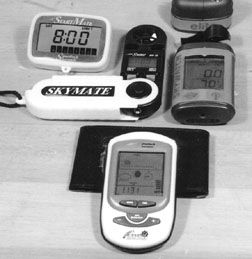
On several occasions in the past Practical Sailor has taken approving note of electronic instruments imported by David Laylin, who runs a company called Speedtech, located in Great Falls, VA.
In fact, in the PS shop are three of Laylin’s instruments; they are used often during some testing procedures. These include his Swiss-made StartMate, which is basically a count-up or count-down stop watch (with a handy beeper) set up to time racing starts and leg durations. Another is the Skywatch Elite, an unusual anemometer and thermometer that records present readings and maximums and minimums in several measurement systems and even has a compass with a bubble level in the cap. (We reviewed the Skywatch Windmate in our Jan. 1, 2005 issue.) The third is the Skymate, an earlier fold-away anemometer-thermometer.
In five years or more, the three instruments are still in perfect working order and never have required battery replacements. All Speedtech instruments have auto-off features, which help to preserve their batteries.
The Skymate and Skywatch Elite are still being sold at $90 each, but the StartMate has been discontinued because of difficulties getting a manufacturer who could meet Laylin’s standards. Not shown in the accompanying photo is an even better “full weather” instrument called the Skymaster ($170), which reads wind, temperature, barometer and humidity.
Basically, Laylin lays out the specifications for these complicated instruments; has them engineered in Switzerland, and manufactured either in Switzerland or, as in the case with his newest wonder, in China.
The newest is called the Mariner’s Edge and what it does is downright amazing. First, it contains tidal data through the year 2099 for 546 locations on the U.S. coast and the Gulf of Mexico. You enter, just once, a code for your nearest tidal port (it comes with a paper table of the 546 ports) and it’ll give, in bar graph displays for the next 24 hours, highs and lows in percentages at 2-hour intervals. In another spot in the window, it gives you the actual times and scopes for highs and lows. Entering your tidal port automatically records the port’s latitude and longitude, and elevation of the nearest airport.
Next, it contains a barometer that reads the barometric pressure every 15 minutes (even when the Mariner’s Edge is turned off), records it, and shows you on a bar chart the air pressure history for the last 24 hours. (As most sailors know, the pressure for the last six hours is the most important.)
Finally, this instrument uses the displayed moon phase, sun and moon positions and barometric pressure, combined with 40 years of detailed fishery research to predict the best times to fish in your home waters.
Wonder of wonders, for most of this data you can scroll forward to any future time, which may be needed when you’re figuring out when to take on tidal currents and even for future fishing trips. (The fishing data for months or years ahead cannot include the weather factors of the shorter fishing forecasts.)
The Mariner’s Edge shows sunrise and sunsets, of course, and gives you a rudimentary weather forecast for the next 6 to 12 hours. A buzzer sounds when the barometric pressure changes in a 3-hour period more than 6 millibars up or down.
Because of all the detailed data displayed, some numbers and letters on the Mariner’s Edge are a bit difficult to read. However, the important data is always boldly legible and, with familiarization and usage, the labeling should be less important. The Mariner’s Edge sells for $117.
Contact – Speed Tech, 800/760-0004, www.speedtech.com.

































May I ask a tech question? My Mariners Edge always displays baro = LLLL . All other functions run perfectly. I know baro is a critical element in forecasting fishing times. Without it, info is not accurate. Any suggestions. Thank you.